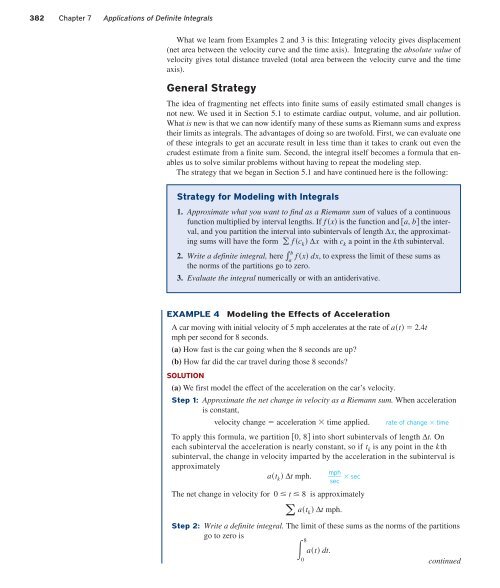Create successful ePaper yourself
Turn your PDF publications into a flip-book with our unique Google optimized e-Paper software.
382 Chapter 7 Applications of Definite Integrals<br />
What we learn from Examples 2 and 3 is this: Integrating velocity gives displacement<br />
(net area between the velocity curve and the time axis). Integrating the absolute value of<br />
velocity gives total distance traveled (total area between the velocity curve and the time<br />
axis).<br />
General Strategy<br />
The idea of fragmenting net effects into finite sums of easily estimated small changes is<br />
not new. We used it in Section 5.1 to estimate cardiac output, volume, and air pollution.<br />
What is new is that we can now identify many of these sums as Riemann sums and express<br />
their limits as integrals. The advantages of doing so are twofold. First, we can evaluate one<br />
of these integrals to get an accurate result in less time than it takes to crank out even the<br />
crudest estimate from a finite sum. Second, the integral itself becomes a formula that enables<br />
us to solve similar problems without having to repeat the modeling step.<br />
The strategy that we began in Section 5.1 and have continued here is the following:<br />
Strategy for Modeling with Integrals<br />
1. Approximate what you want to find as a Riemann sum of values of a continuous<br />
function multiplied by interval lengths. If f x is the function and a, b the interval,<br />
and you partition the interval into subintervals of length Δx, the approximating<br />
sums will have the form f c k Δx with c k a point in the kth subinterval.<br />
2. Write a definite integral, here b f x dx, to express the limit of these sums as<br />
a<br />
the norms of the partitions go to zero.<br />
3. Evaluate the integral numerically or with an antiderivative.<br />
EXAMPLE 4<br />
Modeling the Effects of Acceleration<br />
A car moving with initial velocity of 5 mph accelerates at the rate of at 2.4t<br />
mph per second for 8 seconds.<br />
(a) How fast is the car going when the 8 seconds are up?<br />
(b) How far did the car travel during those 8 seconds?<br />
SOLUTION<br />
(a) We first model the effect of the acceleration on the car’s velocity.<br />
Step 1: Approximate the net change in velocity as a Riemann sum. When acceleration<br />
is constant,<br />
velocity change acceleration time applied. rate of change time<br />
To apply this formula, we partition 0, 8 into short subintervals of length Δt. On<br />
each subinterval the acceleration is nearly constant, so if t k is any point in the kth<br />
subinterval, the change in velocity imparted by the acceleration in the subinterval is<br />
approximately<br />
at k Δt mph. m ph<br />
sec<br />
sec<br />
The net change in velocity for 0 t 8 is approximately<br />
at k Δt mph.<br />
Step 2: Write a definite integral. The limit of these sums as the norms of the partitions<br />
go to zero is<br />
8<br />
at dt.<br />
0<br />
continued












